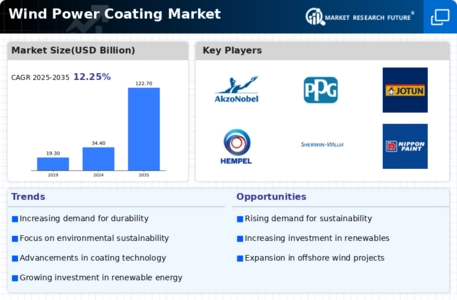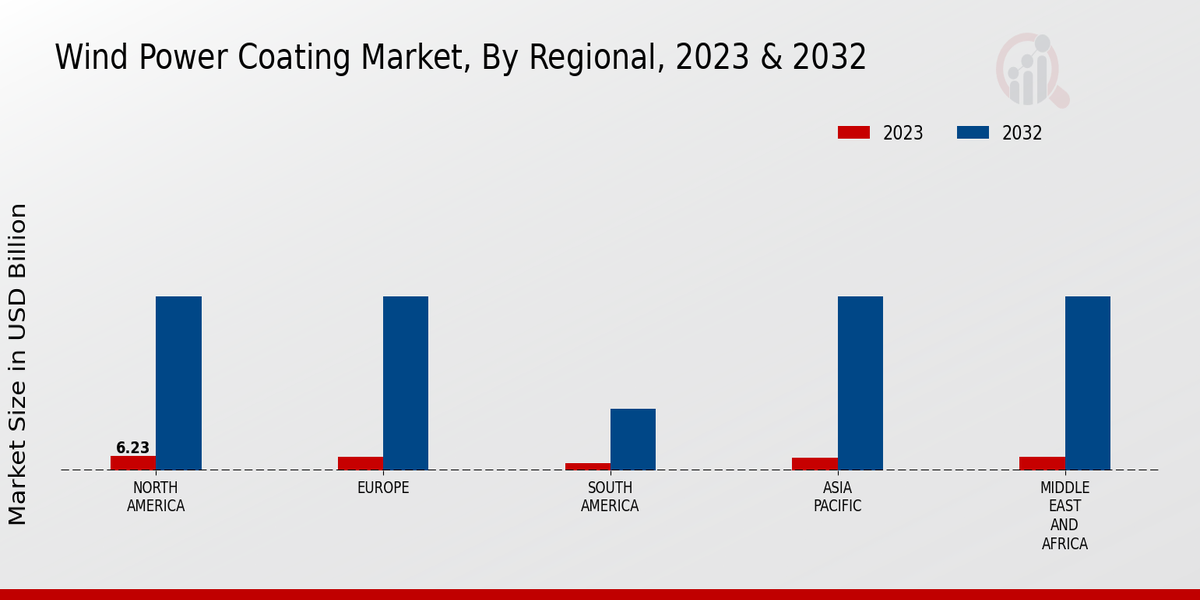Market Growth Projections
The Global Wind Power Coating Market Industry is projected to experience substantial growth, with estimates indicating a market value of 34.4 USD Billion in 2024 and a remarkable increase to 122.7 USD Billion by 2035. This growth trajectory suggests a compound annual growth rate (CAGR) of 12.25% from 2025 to 2035. Such projections highlight the increasing investments in wind energy and the corresponding demand for advanced coating solutions. As the industry adapts to technological advancements and regulatory changes, the market is likely to witness a dynamic evolution, driven by the need for efficient and sustainable energy solutions.
Rising Demand for Renewable Energy
The Global Wind Power Coating Market Industry is experiencing a surge in demand driven by the increasing global emphasis on renewable energy sources. Governments worldwide are implementing policies and incentives to promote wind energy as a sustainable alternative to fossil fuels. For instance, the global wind power capacity is projected to reach approximately 1,000 GW by 2024, necessitating advanced coatings to enhance turbine efficiency and longevity. This trend is expected to contribute significantly to the market's growth, with the industry valued at 34.4 USD Billion in 2024 and anticipated to expand further as investments in wind energy infrastructure increase.
Government Regulations and Incentives
Government regulations aimed at reducing carbon emissions are significantly influencing the Global Wind Power Coating Market Industry. Many countries are establishing stringent environmental standards that encourage the adoption of wind energy. For example, the European Union has set ambitious targets for renewable energy usage, which includes substantial investments in wind power. These regulations not only foster market growth but also create opportunities for coating manufacturers to develop specialized products that meet compliance requirements. As a result, the industry is expected to thrive, with a projected market value of 122.7 USD Billion by 2035, reflecting the positive impact of regulatory frameworks.
Expansion of Wind Energy Infrastructure
The expansion of wind energy infrastructure globally is a critical driver for the Global Wind Power Coating Market Industry. Countries are increasingly investing in wind farms to meet energy demands and reduce reliance on non-renewable sources. For instance, the United States and China are leading in wind energy installations, contributing to a robust market for wind power coatings. This infrastructure growth necessitates high-performance coatings that can withstand harsh environmental conditions, thereby enhancing turbine longevity. As the industry evolves, it is expected to achieve a market value of 122.7 USD Billion by 2035, underscoring the importance of infrastructure development in driving market dynamics.
Technological Advancements in Coating Solutions
Innovations in coating technologies are propelling the Global Wind Power Coating Market Industry forward. Advanced coatings, such as nanostructured and self-healing materials, are being developed to improve the durability and performance of wind turbines. These coatings not only enhance resistance to environmental factors but also reduce maintenance costs, thereby increasing operational efficiency. As manufacturers adopt these cutting-edge solutions, the market is likely to witness substantial growth. The introduction of these technologies aligns with the projected CAGR of 12.25% from 2025 to 2035, indicating a robust future for the industry as it adapts to evolving technological landscapes.
Growing Awareness of Environmental Sustainability
The increasing awareness of environmental sustainability among consumers and businesses is driving the Global Wind Power Coating Market Industry. As stakeholders prioritize eco-friendly practices, the demand for wind energy solutions is rising. This shift in consumer behavior is prompting manufacturers to invest in sustainable coating technologies that minimize environmental impact. The market's growth is further supported by the global push for cleaner energy sources, which is likely to enhance the adoption of wind power. Consequently, the industry is poised for significant expansion, with projections indicating a market value of 34.4 USD Billion in 2024, reflecting this growing trend.




















